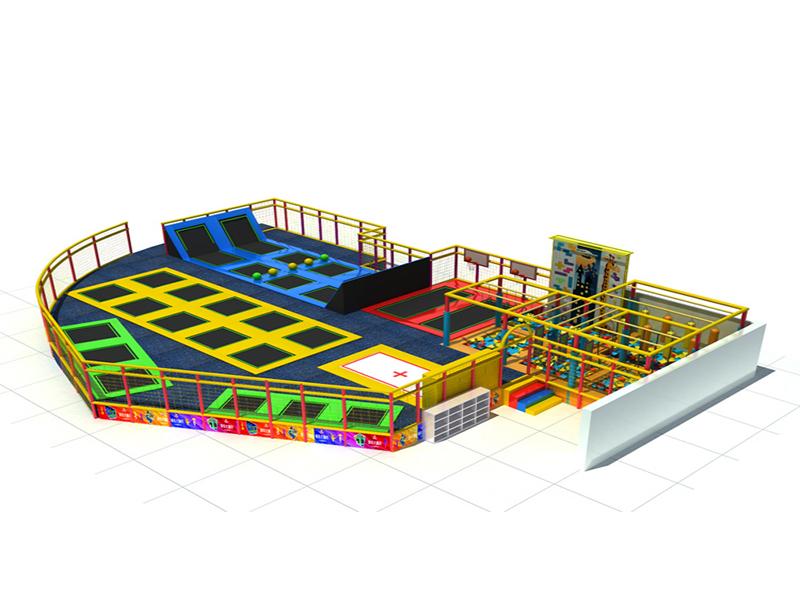Top Trends Every Trampoline Park Manufacturer is Following in 2025
From Smart Tech to Sustainability — What’s Driving 2025’s Trampoline Park Designs


In the rapidly evolving world of recreational entertainment, trampoline parks have become a staple attraction for families, fitness enthusiasts, and thrill-seekers alike. As the industry continues to grow, innovation and safety are more important than ever. Every forward-thinking trampoline park manufacturer is now embracing key trends in 2025 that reflect advancements in technology, consumer expectations, and global market dynamics. This article explores the most significant trends that are shaping the future of trampoline parks across the globe.
Smart Safety Systems Are Becoming Standard
Safety remains the cornerstone of every successful trampoline park. In 2025, manufacturers are integrating smart safety systems that go far beyond padded surfaces and netting. Advanced sensor-based technology is now used to detect unsafe movements, manage jump traffic, and prevent collisions in real time. These smart systems can even monitor trampoline wear and tear, sending alerts when components need maintenance or replacement. Manufacturers are investing heavily in these innovations to meet stricter safety regulations and offer parents peace of mind.
Immersive Experiences with AR and VR
The integration of augmented reality (AR) and virtual reality (VR) has become one of the most exciting trends in trampoline parks. In 2025, trampoline park manufacturers are focusing on creating immersive game environments that allow jumpers to engage in interactive experiences while in motion. Whether it’s dodging virtual obstacles, collecting coins mid-jump, or battling imaginary foes, the combination of physical activity with digital environments offers a new dimension of entertainment. This fusion of technology and movement not only attracts a tech-savvy audience but also extends the appeal of trampoline parks beyond just fitness or fun.
Modular and Customizable Designs
Gone are the days of one-size-fits-all layouts. In 2025, trampoline park designs are more flexible and modular than ever before. Manufacturers are offering customizable components that allow operators to update or change sections of the park based on seasonal trends, customer feedback, or space constraints. These modular systems can include rotating attractions, changeable themes, or even pop-up zones for special events. The ability to adapt ensures that the park remains fresh and engaging, encouraging repeat visits from loyal customers.
Sustainability in Manufacturing and Design
Environmental consciousness is now a priority across all industries, and trampoline park manufacturing is no exception. Eco-friendly materials, energy-efficient lighting, and sustainable manufacturing processes are becoming industry norms. Manufacturers are reducing waste by recycling foam materials, using sustainable steel sources, and designing structures that can be disassembled and reused. In 2025, being green isn’t just good for the planet—it’s also a strong selling point for environmentally conscious consumers and corporate clients.
Integration of Fitness and Wellness Programs
The fitness industry continues to overlap with the world of active play. Modern trampoline parks are no longer just places for fun—they are becoming centers for health and wellness. Manufacturers are designing park layouts that include fitness zones, guided workout circuits, and spaces for instructor-led classes. From trampoline yoga to high-intensity interval training (HIIT) on bouncing surfaces, these innovations are attracting adults who want a dynamic alternative to traditional gyms. This shift also opens doors for corporate wellness partnerships and school collaborations.
Multi-Activity Zones for Broader Appeal
In 2025, trampoline parks are increasingly being designed as multi-attraction venues. Manufacturers are now including ninja courses, climbing walls, foam pits, ziplines, and obstacle courses within the same facility. These multi-activity zones are ideal for drawing in diverse age groups and interest levels, making the park a more attractive destination for families and groups. By expanding the activity offerings, operators can significantly increase time spent at the venue, resulting in better ROI and higher customer satisfaction.
Data-Driven Operations
Another major trend is the use of data analytics to enhance park operations. Manufacturers are incorporating systems that help park operators track foot traffic, identify peak usage times, and understand user behavior. This data can be used to optimize staffing, offer personalized promotions, and plan maintenance more efficiently. The design of the equipment itself is being influenced by data, with popular areas receiving upgrades or expansion based on real-world usage patterns. In short, trampoline park design in 2025 is driven by both creativity and intelligent insights.
Globalization and Custom Compliance
As trampoline parks expand into emerging markets, manufacturers are navigating a complex web of regional safety standards and customer preferences. In 2025, leading companies are designing their products with global adaptability in mind. This includes offering multilingual instruction systems, adjustable structural components for different climate conditions, and compliance with a broad range of international regulations. A trampoline park in India may look different from one in Canada or the UAE, but they share the same design philosophy of inclusivity, safety, and high engagement.
Focus on Themed Experiences
Themed trampoline parks are seeing a massive rise in popularity. Whether inspired by outer space, jungle adventures, superheroes, or futuristic cities, these parks transport visitors into a story-driven environment. Manufacturers are collaborating with theme designers and branding agencies to create cohesive visual and interactive elements that enhance the visitor experience. From themed jump zones to matching uniforms and digital storytelling integrations, the emphasis on themes transforms trampoline parks into memorable destinations rather than generic play areas.
Conclusion
As the trampoline park industry matures, the role of manufacturers has grown far beyond simply building bounce zones. In 2025, they are becoming architects of immersive, safe, and versatile entertainment spaces that cater to a wide audience. From cutting-edge technology and data integration to eco-conscious practices and customizable designs, today’s trends are setting new benchmarks for what a trampoline park can offer. For operators and investors, staying aligned with these trends is key to creating spaces that are not only profitable but also unforgettable for every visitor.




